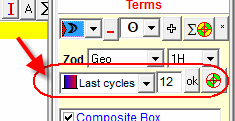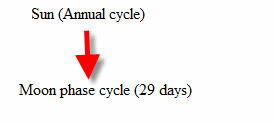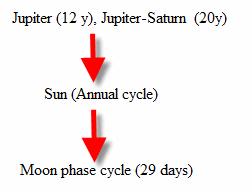
Hierarchic Cycles in astro trading
Introduction
In this article a new kind of cycles will be introduced - hierarchic cycles. Actually, these cycles are not totally new ones. If you are familiar with astro cycles, you definitely would recognize them under this name. But - I have a reason to do that, a reason that has appeared as a result of many years of research. I tried to answer here the question how astro cycles work. It may be surprising, but the answer to this question was not obvious, even for me - though I was writing for more than 15 years the software that main task was to calculate astro cycles. There was always a feeling of some hidden link that might give us the whole picture of astro trading technology. And I tried to find it. For me, it was a very interesting fact that while applying some modern technologies (walk forwards analysis) to find the best trading strategies based on astro cycles we have found a confirmation to classical astrological statements. It has happened that the modern and ancient technologies separated in time by almost 3.000 years have met together! Actually these results have been found by chance, while I conducted back testing for some data trying to find the period within which the astronomical cycles work in the same manner, i.e. the astro structure of the stock market is the same. Looking at these digits I have found that these periods usually correspond to astronomical cycles as well. Now let me show how these cycles work.
Core Idea
It has started with one very practical question: "How much price history should we have to get the best projection line for the Moon phase cycle?" Should we use three last months (i.e. three most recent full Moon phases cycles), or one year, or twenty years? Walk Forward analysis conducted for Dow Jones Industrial index gives us the certain answer: 12 Moon phases cycles or one year. This is how this cycle works for the last 50 years. This is screenshot from my research computer's screen:

Practically it means that the Moon phase cycle works in the same way during one year; the next year that same cycle will work in some other way. In other words, while making one complete year cycle the Sun defines the behavior pattern for the Moon phase cycle. This pattern is valid within one year, and then in a year the Sun starts its next cycle, the new Moon phase behavior pattern will be formed. Speaking symbolically, once a year the Sun sets up for the Moon the job that has to be done.
Remember, we deal here not with regular cycles (like the pattern found for the price being higher at New Moon than at Full Moon). This is "structuring cycle", i.e. during some year the Moon cycle can work as mentioned (the price is higher for New Moon), though for the next year this picture may be switched to an opposite pattern (the price is higher for Full Moon). It is important that the structure for the Moon phase cycle is defined by Annual cycle.
Thus for the Moon phase cycle we have two characteristic parameters:
1) the period itself (i.e. 29 days);
2) the period of "structuring cycle" (one year in our example, it
means that we need to
review this cycle at least once a year).
In Timing Solution you can define the period of "structuring cycle" using "stock market memory" parameter, here it is:

You can find more about stock memory (SM) here: http://www.timingsolution.com/TS/Mini/47/index.htm
Clicking this button you find the period of "structuring cycle":

To perform these calculation we use advance walk forward analysis.
So, as there are structuring cycles for different astro cycles, we can assume that there are structuring cycles of higher level for those structuring cycles. Therefore we can start building the hierarchy of our Cosmos. This is the first brick:

Or, as astrologers say, you may interpret it as "the Moon phase cycle is ruled by the Sun cycle".
Now, let's consider the next level of our hierarchic building. We look closer at the Annual cycle. Annual cycle (the Sun cycle) has also its life: it works now differently than in 1930s. Some general tendencies are still present (like Christmas rally); however, in general it is different.
So, we may ask ourselves a question:
1) speaking astrologically - what astrological cycle rules the Annual (Sun) cycle?
2) mathematically speaking - what is the period of the structuring cycle for the Annual cycle? or: what is the best value for the stock market memory of the Annual cycle?
3) speaking as astro traders - how much price history should we have to calculate the best Annual cycle?
The situation with the Annual cycle is a bit more complicated (compared to the Moon phase cycle). Here are the results of walk forward analysis for Annual cycle:

As you see the strongest cycles here are: Jupiter (12 years), Jupiter-Saturn (20 years) and possibly double Jupiter cycle (24 years). Thus our hierarchic tree looks this way:

It was just a preliminary research. To conduct more research we need much more price history, so we have to wait 1-2 centuries to finalize this construction. However, the general idea is clear now: astro cycles are different from the cycles used by modern science. The difference is that astro cycles have an hierarchy while the science deals with independent cycles.